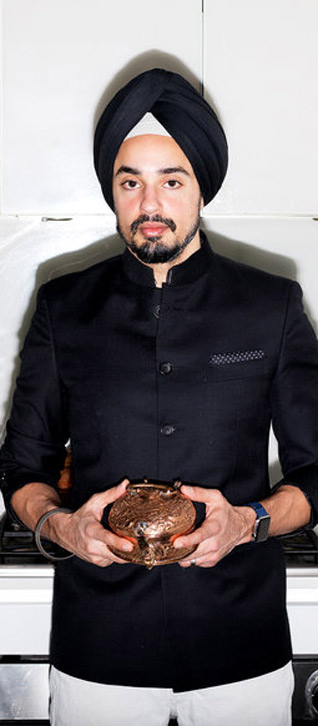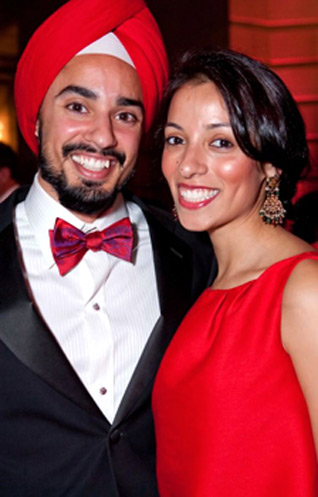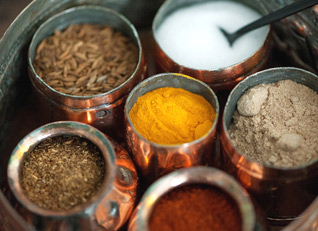Cuisine
In Six Compartments,
All The Flavors Of Home
LIGAYA MISHAN
Before Sandeep “Sonny” Singh Caberwal left his small hometown -- Asheboro, North Carolina, USA -- for college, his mother, aunt and grandmother pulled him into the kitchen.
“I think they thought I was going to starve,” said Sonny, 36, the founder of Bond, a venture that seeks to resurrect the ritual of handwritten correspondence, using robotics.
The women taught him to make raajma, his favorite dish, a Punjabi curry of red kidney beans. Then his mother gave him a loondaani, a round spice tin of beaten copper, the size of a small kettle. Today it sits, shining and ornate with a Braille of flowers, in the coolly modern kitchen of his apartment in the financial district.
Unlatch the domed lid and you find a shallow tray with a long, dainty spoon for measuring. Below are tucked six canisters of spices, five of them -- loon (salt), jeera (cumin), dhania (coriander), laal mirch (red chilli) and amchoor (mango powder) -- arranged like petals around huldi (turmeric) at the center.
“You keep all the spices together so there’s no rummaging around,” Sonny said.
With this, his mother had equipped him to face the world, even though he was going only an hour away, to attend Duke University in Durham, North Carolina. In a sense, he wasn’t leaving home at all: The gurdwara his family regularly attended was in Durham. There he had helped out in the langar where everyone gathered after services to cook and eat together.
The langar meal is free and open to all. “You don’t have to be Sikh,” he said. “Everyone sits together, at the same level, and eats the same food.”
He eventually strayed farther, studying law at Georgetown University. He was living across from the Pentagon on September 11. In the aftermath, a number of Sikh-Americans were harassed and attacked by people who confused their turbans and beards with the garb of Muslim militants.
“Since I was a kid, people always look at you because you’re different,” Sonny said. “But that’s part of being Sikh, to wear the uniform, to look different.
“I’m not the most religious person in the whole world,” he added. But in 2008, he became an ambassador of sorts for the Sikh faith, appearing in a Kenneth Cole ad campaign with the headline “We All Walk in Different Shoes.”
The sight of a Sikh man on a billboard, in a turban and rakish sunglasses, was considered radical enough to be front-page news around the world.
“I’ve always had this idea, how tradition and new things go together,” Sonny said. He briefly played the tabla with the electronic dance band ‘Thievery Corporation’ and, with his wife, Preeti Kaur Bal, a Sikh-American from Ohio, ran an e-commerce site from a New Delhi office near 13th-century monuments.
These days Preeti does most of the cooking, although Sonny tries to take over on weekends, recreating his mother’s dishes. “For our kids” -- a 3-year-old daughter and year-old twin sons -- “it’s important,” he said. “We don’t have the same grounding in Punjabi culture because we were born in the U.S.”
On his first date with Prreti 10 years ago, he cooked dinner. The main course: raajma, whose recipe called for almost every spice in the loondaani.
“I said, ‘Really?’” Preeti said with a laugh. “‘You’re going to feed a girl beans and rice?’”
It worked.
[Courtesy: The New York Times. Edited for sikhchic.com]
January 20, 2016






